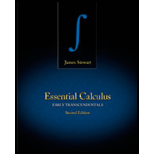
Evaluate each expression without using a calculator.
- (a) (−3)4
- (b) −34
- (c) 3−4
- (d) 523521
- (e) (23)−2
- (f) 16−3/4
(a)
To evaluate: The expression (−3)4 without using a calculator.
Answer to Problem 1ADT
The value of the expression (−3)4 is 81_.
Explanation of Solution
Given expression is (−3)4.
Obtain the value as follows.
(−3)4=(−3)×(−3)×(−3)×(−3)=9×9=81
Therefore, the value of the expression (−3)4 is 81_.
(b)
To evaluate: The expression −34 without using a calculator.
Answer to Problem 1ADT
The value of the expression −34 is −81_.
Explanation of Solution
Given expression is −34.
Obtain the value as follows.
−34=−(3×3×3×3)=−(9×9)=−81
Therefore, the value of the expression −34 is −81_.
(c)
To evaluate: The expression 3−4 without using a calculator.
Answer to Problem 1ADT
The value of the expression 3−4 is 181_.
Explanation of Solution
Given expression is 3−4.
Obtain the value as follows.
3−4=134=13×3×3×3=19×9=181
Therefore, the value of the expression 3−4 is 181_.
(d)
To evaluate: The expression 523521 without using a calculator.
Answer to Problem 1ADT
The value of the expression 523521 is 25_.
Explanation of Solution
Given expression is 523521.
Obtain the value as follows.
523521=523−21 (∵ aman=am−n)=52=5×5=25
Therefore, the value of the expression 523521 is 25_.
(e)
To evaluate: The expression (23)−2 without using a calculator.
Answer to Problem 1ADT
The value of the expression (23)−2 is 94_.
Explanation of Solution
Given expression is (23)−2.
Obtain the value as follows.
(23)−2=1(23)2=1(2232)=1(49)=94
Therefore, the value of the expression (23)−2 is 94_.
(f)
To evaluate: The expression 16−34 without using a calculator.
Answer to Problem 1ADT
The value of the expression 16−34 is 18_.
Explanation of Solution
Given expression is 16−34.
Obtain the value as follows.
16−34=(1614)−3=(4√16)−3=(2)−3=18
Therefore, the value of the expression 16−34 is 18_.
Want to see more full solutions like this?
Chapter T Solutions
Essential Calculus: Early Transcendentals
- Find the area of the shaded region. (a) 5- y 3 2- (1,4) (5,0) 1 3 4 5 6 (b) 3 y 2 Decide whether the problem can be solved using precalculus, or whether calculus is required. If the problem can be solved using precalculus, solve it. If the problem seems to require calculus, use a graphical or numerical approach to estimate the solution. STEP 1: Consider the figure in part (a). Since this region is simply a triangle, you may use precalculus methods to solve this part of the problem. First determine the height of the triangle and the length of the triangle's base. height 4 units units base 5 STEP 2: Compute the area of the triangle by employing a formula from precalculus, thus finding the area of the shaded region in part (a). 10 square units STEP 3: Consider the figure in part (b). Since this region is defined by a complicated curve, the problem seems to require calculus. Find an approximation of the shaded region by using a graphical approach. (Hint: Treat the shaded regi as…arrow_forwardSolve this differential equation: dy 0.05y(900 - y) dt y(0) = 2 y(t) =arrow_forwardSuppose that you are holding your toy submarine under the water. You release it and it begins to ascend. The graph models the depth of the submarine as a function of time. What is the domain and range of the function in the graph? 1- t (time) 1 2 4/5 6 7 8 -2 -3 456700 -4 -5 -6 -7 d (depth) -8 D: 00 t≤ R:arrow_forward
- 0 5 -1 2 1 N = 1 to x = 3 Based on the graph above, estimate to one decimal place the average rate of change from x =arrow_forwardComplete the description of the piecewise function graphed below. Use interval notation to indicate the intervals. -7 -6 -5 -4 30 6 5 4 3 0 2 1 -1 5 6 + -2 -3 -5 456 -6 - { 1 if x Є f(x) = { 1 if x Є { 3 if x Єarrow_forwardComplete the description of the piecewise function graphed below. 6 5 -7-6-5-4-3-2-1 2 3 5 6 -1 -2 -3 -4 -5 { f(x) = { { -6 if -6x-2 if -2< x <1 if 1 < x <6arrow_forward
- Let F = V where (x, y, z) x2 1 + sin² 2 +z2 and let A be the line integral of F along the curve x = tcost, y = t sint, z=t, starting on the plane z = 6.14 and ending on the plane z = 4.30. Then sin(3A) is -0.598 -0.649 0.767 0.278 0.502 0.010 -0.548 0.960arrow_forwardLet C be the intersection of the cylinder x² + y² = 2.95 with the plane z = 1.13x, with the clockwise orientation, as viewed from above. Then the value of cos (₤23 COS 2 y dx xdy+3 z dzis 3 z dz) is 0.131 -0.108 -0.891 -0.663 -0.428 0.561 -0.332 -0.387arrow_forward2 x² + 47 The partial fraction decomposition of f(x) g(x) can be written in the form of + x3 + 4x2 2 C I where f(x) = g(x) h(x) = h(x) + x +4arrow_forward
- The partial fraction decomposition of f(x) 4x 7 g(x) + where 3x4 f(x) = g(x) = - 52 –10 12x237x+28 can be written in the form ofarrow_forward1. Sketch the following piecewise function on the graph. (5 points) x<-1 3 x² -1≤ x ≤2 f(x) = = 1 ४ | N 2 x ≥ 2 -4- 3 2 -1- -4 -3 -2 -1 0 1 -1- --2- -3- -4- -N 2 3 4arrow_forward2. Let f(x) = 2x² + 6. Find and completely simplify the rate of change on the interval [3,3+h]. (5 points)arrow_forward

 Holt Mcdougal Larson Pre-algebra: Student Edition...AlgebraISBN:9780547587776Author:HOLT MCDOUGALPublisher:HOLT MCDOUGAL
Holt Mcdougal Larson Pre-algebra: Student Edition...AlgebraISBN:9780547587776Author:HOLT MCDOUGALPublisher:HOLT MCDOUGAL Elementary AlgebraAlgebraISBN:9780998625713Author:Lynn Marecek, MaryAnne Anthony-SmithPublisher:OpenStax - Rice University
Elementary AlgebraAlgebraISBN:9780998625713Author:Lynn Marecek, MaryAnne Anthony-SmithPublisher:OpenStax - Rice University Algebra: Structure And Method, Book 1AlgebraISBN:9780395977224Author:Richard G. Brown, Mary P. Dolciani, Robert H. Sorgenfrey, William L. ColePublisher:McDougal Littell
Algebra: Structure And Method, Book 1AlgebraISBN:9780395977224Author:Richard G. Brown, Mary P. Dolciani, Robert H. Sorgenfrey, William L. ColePublisher:McDougal Littell



